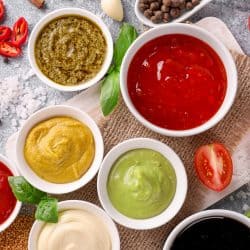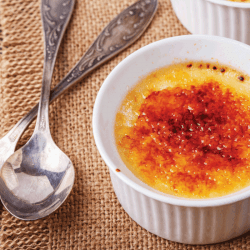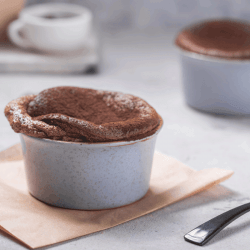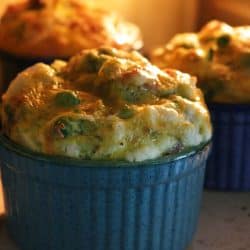![Two ramekin with chak chak on a white table, What Is A Ramekin? [Pictures, Shopping Guide & Alternatives]](https://kitchenseer.com/wp-content/uploads/2020/05/What-Is-A-Ramekin-Pictures-Shopping-Guide-Alternatives.jpg) Unless you love French cooking, chances are you don’t know what a ramekin is. Once you learn more about ramekins, however, you’ll quickly understand why many chefs always keep a stack on hand. Don’t worry; we’ve done all the research on ramekins so you don’t have to.
Unless you love French cooking, chances are you don’t know what a ramekin is. Once you learn more about ramekins, however, you’ll quickly understand why many chefs always keep a stack on hand. Don’t worry; we’ve done all the research on ramekins so you don’t have to.
Ramekins are circular, oven-safe dishes that are each good for one portion. Classically, these bowls are white, made with glazed ceramic, and have fluted sides. Ramekins are strongly associated with classic French cuisine, especially crème brûlée, soufflés, and French onion soup.
Although ramekins are closely linked with French food, they have countless potential uses in the kitchen. Please read through the rest of this post to find out everything you need to know about these delightful dishes.
Ramekin 101: History & Common Uses
First off, let’s briefly go over everything you need to know about the ramekin’s history and standard design. Below, we’ll also share the most popular ways you could put these dishes to good use.
What's The History Of The Ramekin?
Many etymologists believe the word “ramekin” first appeared in the 17th century in Northern Europe. According to scholars, “ramekin” contains the old German word “rom,” which means “cream.”
It seems many German, Dutch, and Flemish people initially used the word “ramekin” to describe creamy dishes that contained eggs, meat, or cheese. Eventually, people must have started using “ramekin” to describe both these single-portion dishes and the ceramic molds they were made in.
Even today, “ramekin” could be used to describe single-serve, creamy recipes or the ceramic dishes detailed in this post.
What Are Ramekins Typically Made Of?
Typically, ramekins are white, circular, and made with glass-glazed ceramic. There’s no standard size for ramekins, but you’ll commonly find models that hold between 4 – 6 ounces.
Other traditional ramekin design features include:
- Fluted exterior
- Smooth interior
- Straight edges
- Diameter of about 3’’ to 4’’
Here’s what a standard set of ceramic ramekins looks like.
Click here to see more on Amazon.
Nowadays, you could find loads of non-traditional ramekin models for sale. For instance, porcelain ramekins are becoming increasingly popular.
Click here to see more on Amazon.
Interestingly, there are even disposable aluminum ramekins now available. Just be extra careful if you’re making crème brûlée with these ramekins.
Click here to see more on Amazon.
By the way, if you’re interested in learning more about the pros & cons of common materials like steel or glass, you might enjoy this post: Is It Better To Store Food In Plastic, Glass, Or Stainless Steel?
What Foods Do People Make In Ramekins?
As already mentioned, ramekins are strongly associated with classic French dishes, especially the dazzling dessert crème brûlée. Indeed, since crème brûlée is such an iconic dish, many manufacturers sell their ramekins with blowtorches, caramelizing sugar, and a crème brûlée mix.
Click here to see more on Amazon.
But the ramekin is far from a one-hit-wonder. Here’s a sampling of other awesome dishes you could make in a ramekin:
- French onion soup
- Soufflés
- Chicken pot pie
- Molten lava cake
- Mac & cheese
- Oven-baked eggs
- Tuna tartare
- Mini fruit pies
- Pudding
- Shrimp au gratin
By the way, you could also use ramekins in a bain-marie. Before you do so, please read through this post: Is a Double Boiler (Bain Marie) Supposed to Touch the Water?
Besides Baking, What Could I Use Ramekins For?
Once you get a set of ramekins, you’ll be amazed at how useful they are in the kitchen. First off, you could use them to pre-measure spices and herbs before putting them in your recipes. This is an excellent tip if you’re handling raw meat because you won’t have to worry about spreading salmonella on your S&P shakers!
Since ramekins are designed for one serving, they are also fantastic for snacking. Feel free to measure some chips, nuts, or fruit in ramekins. Many people also use ramekins for oatmeal, ice cream, and cereal.
If you’re someone who likes to do a lot of entertaining, then ramekins will add some fancy French flair to your get-togethers. You don’t even have to cook elaborate soufflés to wow your guests. For instance, you could put spicy salsa, creamy queso, or glorious guacamole in your ramekins with a side of chips.
Common Questions People Have About Ramekins
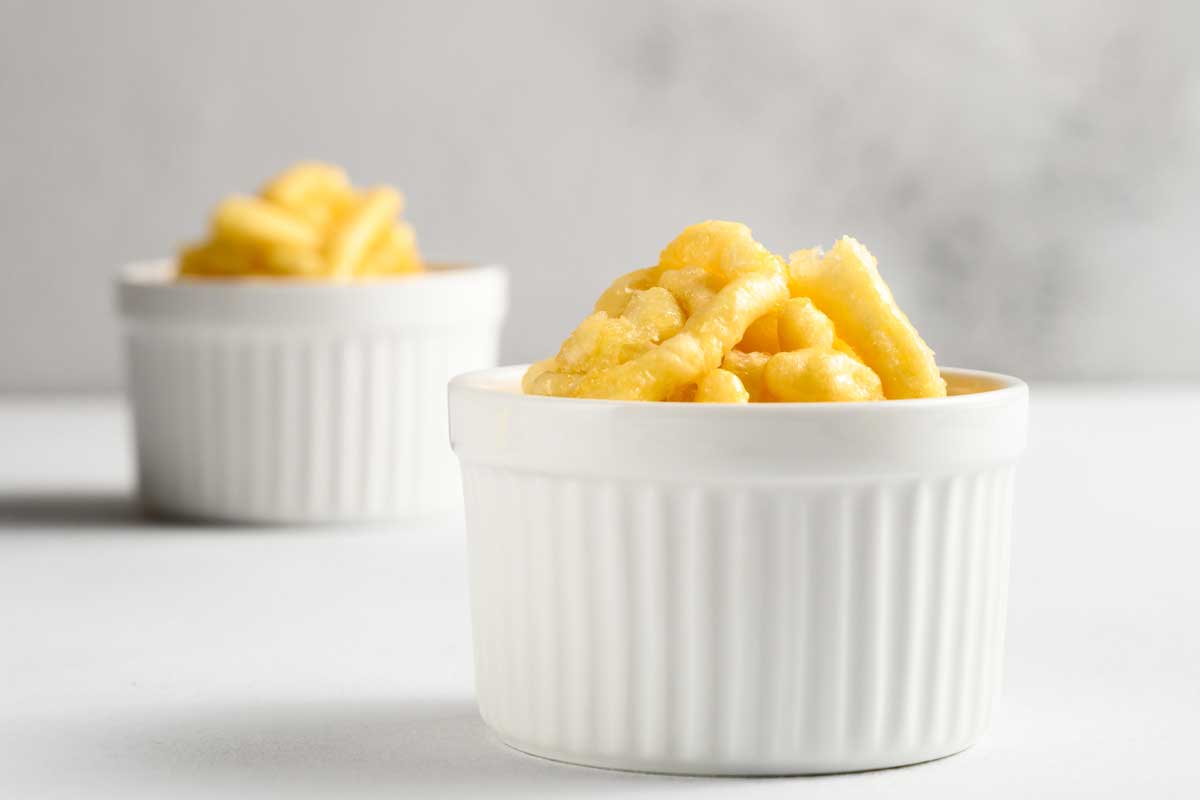
If you still have questions about ramekins, then be sure to read through this second section. Below, we’ll go over a few of the top ramekin-related FAQs.
How Much Does A Ramekin Typically Cost?
Ramekins may look impressive, but they’re quite inexpensive. You will commonly find ceramic ramekins retailing for $2 – $5 each.
Since most people need more than one ramekin, manufacturers often sell their ramekins as a set. Expect to pay somewhere in the $15 – $20 range for four ceramic ramekins.
Can Pyrex Ramekins Go In The Oven?
Pyrex is a special glass material that’s known for its ability to handle high temperatures. If you own ramekins made with Pyrex, then you can safely place them in the oven.
You should not, however, take Pyrex ramekins from your fridge or freezer and immediately pop them in a steamy oven. This rapid change in temperatures could easily cause your Pyrex to shatter.
Please ensure your Pyrex ramekins are at room temperature before you place them in the oven. Of course, if you have any specific questions about your ramekins, check what your manufacturer has to say.
What Could I Use Instead Of A Ramekin?
Do you despise traditional ramekin designs? No problem. Here are a few ramekin alternatives for your consideration.
1. Pyrex Custard Cups
If you’re not interested in making soufflés, then you might be interested in purchasing a few Pyrex custard cups. Just like ramekins, these glass cups are safe for use in the oven and can cook a fantastic variety of single-serve dishes.
One distinction to keep in mind, however, is that Pyrex custard cups curve outwards while traditional ramekins have straight edges. Sadly, your soufflé will sag if you try to make it in a custard cup. Some chefs also complain custard cups don’t produce satisfying oven-baked eggs.
There are some instances, however, when you might like the Pyrex cup's curved sides. For example, if you need to mix a scrambled egg into a sauce slowly, then you'll have an easier time pouring from a Pyrex cup versus a straight edge ramekin.
Since Pyrex cups are see-through, some people claim they are easier to clean than ramekins. Simply hold your Pyrex cups up to the light to inspect for any gunk or debris.
Take a peek at these standard Pyrex custard cups to see if they meet your expectations.
Click here to see more on Amazon.
2. Oven-Safe Crocks
Soup fanatics may prefer working with oven-safe crocks rather than ramekins. On average, crocks are larger than ramekins, which means you could make far more soup per container. Since most people use crocks to make French onion soup, they are also usually safe for use under a broiler.
For added convenience, many soup crocks have handles. Although you'll still need oven mitts to carry your crocks out of the oven safely, they are easier to "handle" than standard ramekins.
On the downside, oven-safe crocks aren’t as versatile as ramekins or custard cups. If you’re only interested in whipping up satisfying soup, however, then these oven-safe crocks will serve you well.
Check out these ceramic mugs designed explicitly for French onion soup.
Click here to see more on Amazon.
3. Hot Pot
Although “hot pot” cooking has been around for centuries, it has only “caught fire” in the West within the past few years. To oversimplify a bit, “hot pot” refers to a primarily Asian style of cooking & eating where friends and family cook their food in, well, a hot pot!
"Hot pots" typically hold 30 – 40 fluid ounces, so they are far larger than ramekins. Plus, "hot pots" are usually safe for both the stovetop and the oven. Ramekins, on the other hand, shouldn't be used on a stovetop.
Ordering a hot pot set could be a fun addition to your kitchen, especially if you enjoy cooking Asian dishes with friends.
Anyone interested in this cooking style should take a peek at this authentic Korean hot pot set.
Click here to see more on Amazon.
FYI: anyone who loves Asian cooking should read this post: Should A Wok Be Nonstick?
Can You Put Ramekins In The Freezer?
Yes, you can safely place most ceramic and porcelain ramekins in the freezer. You should see a clear “freezer-approved” label on your product’s packaging. If not, please give your manufacturer a call just to be safe.
Add Some Ramekins To Your Cooking Routine
As you can see, ramekins are far more than fancy cups for crème brûlée. Whatever cuisine you enjoy, you’re bound to find dozens of uses for these inexpensive dishes.







